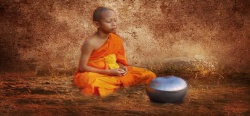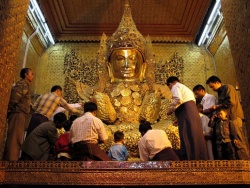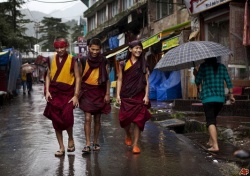Patisandhi
lit. 'reunion, relinking', i.e. rebirth, is one of the 14 functions of consciousness (viññāna-kicca). It is a karma-resultant type of consciousness and arises at the moment of conception i.e. with the forming of new life in the mother's womb. Immediately afterwards it sinks into the subconscious stream of existence (bhavangasota), and conditioned thereby ever and ever again corresponding states of sub consciousness arise. Thus it is really rebirth-consciousness that determines the latent character of a person.
"Neither has this (rebirth-) consciousness transmigrated from the previous existence to this present existence, nor did it arise without such conditions, as karma, karma-formations, propensity, object, etc. That this consciousness has not come from the previous existence to this present existence, yet that it has come into existence by means of conditions included in the previous existence, such as karma (q.v.), etc., this fact may be illustrated by various things, such as the echo, the light of a lamp, the impression of a seal, or the image produced by a mirror. For just as the resounding of the echo is conditioned by a sound, etc., and nowhere a transmigration of sound has taken place, just so it is with this consciousness. Further it is said: 'In this continuous process, no sameness and no otherness can be found.' For if there were full identity (between the different stages), then also milk never could turn into curd. And if there were a complete otherness, then curd could never come from milk.... If in a continuity of existence any karma-result takes place, then this karma-result neither belongs to any other being, nor does it come from any other (kamma), because absolute sameness and otherness are excluded here" (Vis, XVII 164ff).
In Mil. it is said:
"Now, Venerable Nāgasena, the one who is reborn, is he the same as the one who has died, or is he another?"
"Neither the same, nor another" (na ca so na ca añño).
"Give me an example."
"What do you think, o King: are you now, as a grown-up person, the same that you had been as a little, young and tender babe? "
"No, Venerable Sir. Another person was the little, young and tender babe, but quite a different person am I now as a grown-up man . " . . .
"... Is perhaps in the first watch of the night one lamp burning, another one in the middle watch, and again another one in the last watch?"
"No, Venerable Sir. The light during the whole night depends on one and the same lamp.
"Just so, o King, is the chain of phenomena linked together. One phenomenon arises, another vanishes, yet all are linked together, one after the other, without interruption. In this way one reaches the final state of consciousnes neither as the same person. nor as another person.
According to the nature of their rebirth consciousness, beings divide into the following 3 groups:
1. ahetu-patisandhika: a 'being reborn without root-conditions', is a being whose consciousness at the moment of rebirth was not accompanied by any of the 3 noble root-conditions, viz. greedlessness, hatelessness, undeludedness (s. mūla), i.e. selflessness, kindness, intelligence. Such beings are found in the 4 lower worlds (apāya), in which case the function of rebirth is exercised by the class of consciousness listed in Tab. I as No. 56. But if such beings are born in the sensuous sphere as humans, they will be crippled, blind, deaf, mentally deficient, etc. (Rebirth-consciousness = Tab. I, No. 41)
2. dvihetu (or duhetu)-patisandhika: a 'being reborn with only 2 (noble) root-conditions', i.e. greedlessness and hatelessness. (Rebirth-consciousness = Tab. I, Nos. 44, 45, 48 or 49.)
3. tihetu-patisandhika: a 'being reborn with 3 (noble) root-conditions'. Such a being can be found only among men. (Rebirth-consciousness = Tab. I, Nos. 42, 43, 46, or 47) and higher heavenly beings.
On these 3 types of rebirth, See Atthasālini Tr. 11, 354 - 379. (App.: patisandhika).
In the suttas, the terms for rebirth are chiefly
punabbhava (q.v.), 'renewed existence', and
abhinibbatti 'arising';
or both combined as punabbhavābhinibbatti. - (App.: patisandhi).
Literature
Vis.M. XVII, 133f, 164f, 189f, 289f; Vis.M. XIX, 22f. -
Karma and Rebirth, by Nyanatiloka Thera (WHEEL 9). -
The Case for Rebirth, by Francis Story (WHEEL 12/13). -
Survival and Karma in Buddhist Perspective, by K. N. Jayatilleke (WHEEL 141/143). -
Rebirth Explained, by V. F. Gunaratna (WHEEL 167/169).



